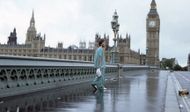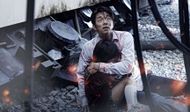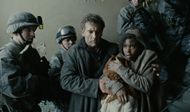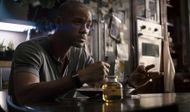If you watched 28 Years Later and felt unsettled by how real it all seemed, then you are definitely not the only one. The film didn’t try to shock you with nonstop violence or cheap jump scares. It focused on how people fall apart when the world around them stops making sense.
In 28 Years Later, the fear came from what could actually happen. The infected moved fast. The government lost control. The streets looked empty and dangerous. The quiet moments were just as intense as the loud ones. That kind of horror stays with you because it feels like it could be right around the corner.
Now, if that feeling stuck with you and you want more stories that carry the same weight, then there are other films you should check out. Some deal with outbreaks. Others show what life looks like after the worst has already happened.
These movies, like 28 Years Later, take their time and let fear build slowly. They focus on how people react when things fall apart. None of them are easy to watch, and that is the point. If 28 Years Later left an impact on you, then these seven films will hit just as hard in their own way.
If you loved 28 Years Later, you must check out these 7 horror films next
1. 28 Days Later (2002)

The film opens with Cillian Murphy’s character waking up alone in a hospital and stepping into a city that has completely fallen apart. He walks through an empty London with no answers and no people in sight. Within minutes, he discovers that what’s left of society is violent and fast-moving.
The infected are not zombies in the traditional sense. They are alive and aggressive and driven by pure rage. The infection spreads through blood and saliva and takes hold within seconds. The film uses shaky camera work and minimal sound to heighten the sense of panic.
What makes the Danny Boyle directorial so effective is how real everything feels. The streets look familiar and the violence feels unplanned. The film showed how society can collapse without warning and how survival means adapting quickly. It laid the groundwork for everything that followed in the series and helped shape modern apocalyptic horror.
28 Years Later continues the story that 28 Days Later started in 2002, by expanding on the Rage virus and showing how the infection evolved over decades.
2. Train to Busan (2016)

The story begins with a father and daughter boarding a train in Seoul. They are trying to reach the child’s mother in Busan. As the train departs, news breaks of a violent outbreak spreading across the country. A bitten passenger brings the infection onboard.
Within minutes, chaos spreads through the narrow train cars. Passengers are forced to block doors and move between cars while trying to avoid the infected. The confined space means that nowhere is safe for long. The zombies move fast and in packs, and the characters have to constantly adjust to survive.
Yeon Sang-ho's film is relentless but never loses focus on emotion. Characters form bonds and sacrifice themselves to protect others. The ending hits hard because the journey never felt exaggerated. It captured panic, urgency, and heartbreak without trying to be bigger than it needed to be. It raised the bar for zombie films everywhere.
Like 28 Years Later, Train to Busan shows how fast a viral outbreak can destroy society and force strangers into brutal life-or-death decisions.
3. The Road (2009)

The film begins with a father and son moving through a destroyed and lifeless America. The landscape is grey and dead and covered in ash. There are no animals and no crops, and almost no people. Whatever caused the collapse is never explained.
The two avoid towns and roads because they know what desperation has done to the people left behind. They carry a cart of supplies and a gun with only two bullets. The father teaches his son how to survive without becoming cruel. Every step forward feels like a risk.
John Hillcoat's directorial is not a movie about fighting back like 28 Years Later. It is about trying to hold on to goodness when there is none around you. The scenes are quiet and slow and heavy. There are no easy moments. It forces you to sit with the fear and ask what you would do in the same world.
28 Years Later and The Road both portray a world that has already ended, where survival depends more on avoiding people than escaping the original disaster.
4. Children of Men (2006)

The world has not seen a human birth in 18 years. Countries are collapsing, and the United Kingdom has become a violent police state. Refugees are hunted,d and cities are torn apart by bombings. This is where the story starts in the Alfonso Cuarón film.
Clive Owen plays a man who gave up on hope a long time ago. He is asked to protect a pregnant woman and take her to safety. He does not know if she will survive or if anyone will care. He only knows she must be protected at all costs.
Like 28 Years Later, the film shows violence that feels messy and uncontrolled. It never looks clean or planned. Scenes unfold in long, unbroken shots that keep you trapped in the moment. It is not about saving the world. It is about helping one person survive long enough to matter. That makes every scene feel urgent and necessary.
Children of Men shares 28 Years Later’s bleak tone and setting, where the breakdown of government and trust turns every human interaction into a risk.
5. REC (2007)

A news crew follows firefighters on what should be a routine emergency call. They enter an apartment building in Barcelona where strange noises have been reported. Within moments, a resident attacks someone. The building is sealed from the outside.
No one knows what is happening. The infected move quickly, and the virus spreads through bites. The news crew records everything as residents scream and panic. Stairwells become traps. Hallways are too narrow to escape. No help arrives from the outside.
The camera never cuts to a safe angle in this film directed by Jaume Balagueró and Paco Plaza. You see only what the cameraman sees. That makes the fear feel real. The panic builds without breaks. When the truth is finally revealed, it is worse than expected. REC uses its setting and format to pull you into the fear and keep you there until the final second.
28 Years Later and REC both trap characters in escalating outbreaks where the infection spreads fast and help from the outside never comes.
6. It Comes at Night (2017)

The world outside is already broken when the film begins. A family lives in a boarded-up house deep in the woods. They follow strict rules to keep a virus from getting in. One day, a man arrives with his wife and child, asking for shelter.
They agree to share the space, but things never feel safe. Trey Edward Shults' film shows both families trying to trust each other. But as time passes, that trust wears down. Strange noises at night and missing items raise suspicion. Fear spreads faster than the disease.
Nothing about the virus is explained. The fear comes from what people might do to survive. Every movement feels watched. Every conversation feels like a test. The film does not try to scare you with action. It builds fear by showing how thin the line is between caution and cruelty.
It Comes at Night echoes 28 Years Later by showing how fear of infection leads to paranoia, isolation, and violence even among those who aren’t infected.
7. I Am Legend (2007)

New York is empty. Grass grows on the streets, and cars sit abandoned. Will Smith plays a scientist who is possibly the last person alive. A virus meant to cure cancer has killed most of the population and mutated the rest into violent creatures.
He spends his days collecting food and searching for a cure. At night, he hides behind metal shutters while the infected roam. He speaks to mannequins in a video store to stay sane. His only companion is a German shepherd.
Like 28 Years Later, the film mixes quiet isolation with sudden danger. The infected are not just violent but also learning. They set traps and remember. The story shows what it means to lose everything and still hold onto purpose. Even when hope is nearly gone, he keeps working. That focus is what keeps Francis Lawrence's film grounded and makes the protagonist's story feel real.
28 Years Later and I Am Legend both explore a world where a man-made virus destroys civilization and the infected evolve into something unpredictable and deadly.
Follow for more updates.
Love movies? Try our Box Office Game and Movie Grid Game to test your film knowledge and have some fun!
